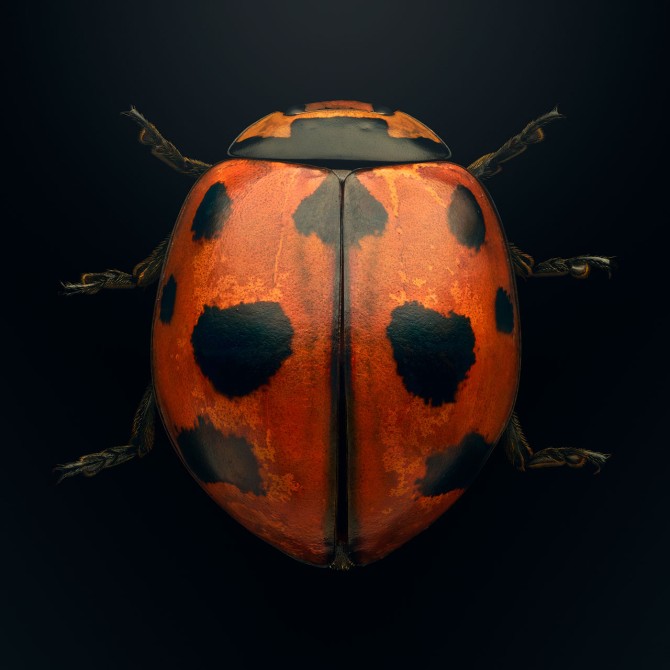NYC exhibition features plight of the ninespotted lady beetle
By Caitlin Hayes, Cornell Chronicle
A new exhibition at the American Museum of Natural History will call attention to the plight of the ninespotted lady beetle – once so prevalent and valuable for pest control it was deemed New York’s official state insect – and will feature a lady beetle specimen from Cornell.
The exhibition, “Extinct and Endangered,” opens June 22 in New York City and is based on the macrophotography of renowned artist Levon Biss. Biss used microscope lenses to create large-scale images of 40 species at incredibly high resolution, layering up to 10,000 shots for each image. The photos were then blown up to measure as large as 4.5 by 8 feet.
“It brings attention to the fact that these little bugs that are usually underfoot are out there, and they’re important,” said Todd Ugine, research associate in the lab of John Losey, professor of entomology. “Having these images blown up to that size gives people a different kind of access – you notice the detail and the beauty, and I hope that accessibility will bleed into awareness of their decline.”
After the museum reached out to Losey in fall of 2020, Ugine grew the specimen from a colony of ninespotted lady beetles he cares for and researches in the lab. He carefully selected a batch to send to David Grimaldi, Ph.D. ‘86, a curator of invertebrate zoology at the museum, who prepared a smaller selection for Biss. The remaining beetles will be kept in the museum’s permanent research collection.
A U.S. Department of Agriculture survey in 2009 found no trace of the once-ubiquitous ninespotted lady beetle, Coccinella novemnotata, east of the Mississippi – with the exception of one population on Long Island. Previous research in the Losey lab has pointed to the source of the beetle’s mysteriously rapid decline in the 1980s: nonnative ladybugs that were introduced to improve pest control.
“Some of the species introduced were great at eating the same pests the native species ate,” Ugine said. “We think these nonnative species vacuumed up all the food and the native species were out-competed, and that seems to be borne out in the laboratory work we’ve done.”
Ugine hopes the show will bring attention to efforts to restore the ninespotted lady beetle to its native range, and the larger problem of global insect declines. Having studied and honed breeding of the beetle, the lab has been releasing them into the wild, and larvae and beetles are available for purchase through the Lady Bug Rescue, managed by two Cornell Ph.D. alum and current research associates in Losey’s lab. The rescue was started in 2016, after eight years of gathering citizen science data about ladybug sightings through the Lost Lady Bug Project, founded by Losey, and seeing declining reports of the ninespotted lady beetle. To scale up and optimize the reintroduction efforts, more research and funding is needed, Ugine said.
“That one population on Long Island is co-existing with the nonnative species, so maybe that small population happens to have some trait or set of traits that allows them to persist,” he said. “I’d love to go back to that population to use it as a source for reintroduction.”
This population could then be “ranched,” Ugine said – bred by the hundreds of thousands under a protective covering, and released and tracked to see how and whether they survive and adapt.
In 2019, scientists reported that 40% of all insects are in decline globally and that a third of them are endangered. Ugine said the value of reintroducing the ninespotted lady beetle is the value of biodiversity itself.
“When you lose a species, you’re losing an ecological service,” Ugine said. “Who knows what additional kinds of services it might have provided, in terms of pest control, or even pharmaceuticals. If you don’t have it around, you can’t study those things. That’s all lost.”
Furthermore, biodiversity inspires, Ugine continued. “If we had never seen anything flying around, would we have planes?” he said. “Look at Levon Biss’ images – it’s powerful.”
The exhibition features 39 other species, including the declining Monarch butterfly, and the endangered Puritan tiger beetle, Hawaiian hammer-headed fruit fly, Mt. Hermon June beetle, and San Joaquin flower-loving fly. The museum will be releasing a companion book of the images and a “making of” video, and the show will eventually travel to other museums.
Get Cornell news delivered right to your inbox.
Subscribe

